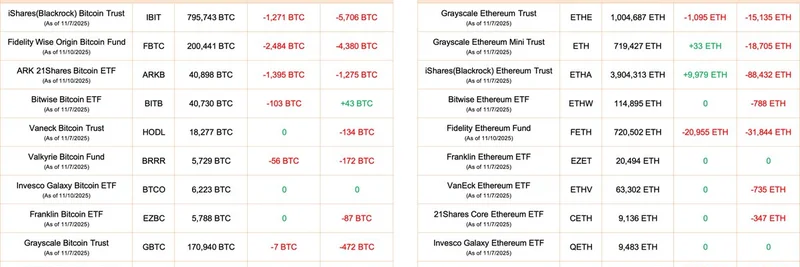The crypto world is buzzing with the latest update from on-chain analytics firm Lookonchain, highlighting significant outflows from major Bitcoin and Ethereum ETFs. Posted on X (formerly Twitter) by @lookonchain, the data reveals a net outflow of over 5,300 BTC and 12,000 ETH in a single day, signaling potential shifts in institutional sentiment. But what does this mean for meme coin enthusiasts? Let's break it down step by step.
First off, ETFs—or Exchange-Traded Funds—are investment vehicles that track the price of assets like Bitcoin and Ethereum, allowing traditional investors to gain exposure without directly holding the crypto. These funds have been a game-changer since their approval, bringing billions into the market. The recent data, dated as of November 7, 2025 (despite the post being on November 10), shows a red day across the board.
Looking at the Bitcoin side, the total net inflow for the 10 tracked ETFs was a negative 5,317 BTC, equating to about $564.78 million in outflows. Fidelity's Wise Origin Bitcoin Fund (FBTC) led the pack with 2,484 BTC ($263.9 million) exiting, leaving them with 200,441 BTC in holdings—still a hefty $21.29 billion position. Other notable movers include iShares Bitcoin Trust (IBIT) with a minor outflow of 1,271 BTC and ARK 21Shares Bitcoin ETF (ARKB) shedding 1,395 BTC. Grayscale's Bitcoin Trust (GBTC) saw a small 7 BTC outflow, but their mini trust actually gained 0 BTC net.
On the Ethereum front, things weren't much brighter. The nine ETFs reported a combined net outflow of 12,039 ETH, worth around $43.34 million. Fidelity's Ethereum Fund (FETH) was the biggest loser here too, with 20,955 ETH ($75.44 million) flowing out, trimming their holdings to 720,502 ETH ($2.59 billion). Grayscale's Ethereum Trust (ETHE) lost 1,095 ETH, while their mini trust surprisingly gained 33 ETH. iShares Ethereum Trust (ETHA) bucked the trend with a positive 4,979 ETH inflow, but overall, the sector closed in the red.
Replies to the tweet add some context—users pointed out that this data lags by a day or so, reflecting Friday's (November 7) activity rather than real-time Monday moves. One commenter noted it as "last week's data," while others speculated on retail-driven panic during corrections or smart money repositioning ahead of economic data like CPI reports.
Now, tying this back to meme tokens: These ETF flows often act as a barometer for broader market liquidity. When institutions pull back from blue-chip cryptos like BTC and ETH, it can create ripple effects in the more volatile meme coin space. Meme tokens, built on community hype and quick flips, thrive on abundant liquidity. Outflows like these might signal tightening conditions, potentially leading to sharper dips in tokens like Dogecoin, Shiba Inu, or emerging pumps on Solana and Base chains. On the flip side, if this is just short-term de-risking, a rebound in ETF inflows could fuel the next meme rally.
For blockchain practitioners eyeing meme opportunities, keep an eye on tools like Lookonchain for on-chain insights. This data underscores the importance of monitoring institutional moves—they often precede retail trends. If you're building or trading in the meme ecosystem, consider how ETF sentiment influences overall crypto capital flows.
In summary, while these outflows paint a cautious picture, they're part of the market's natural ebb and flow. Meme insiders, stay vigilant: what starts in ETFs could end up boosting or busting your favorite tokens.




